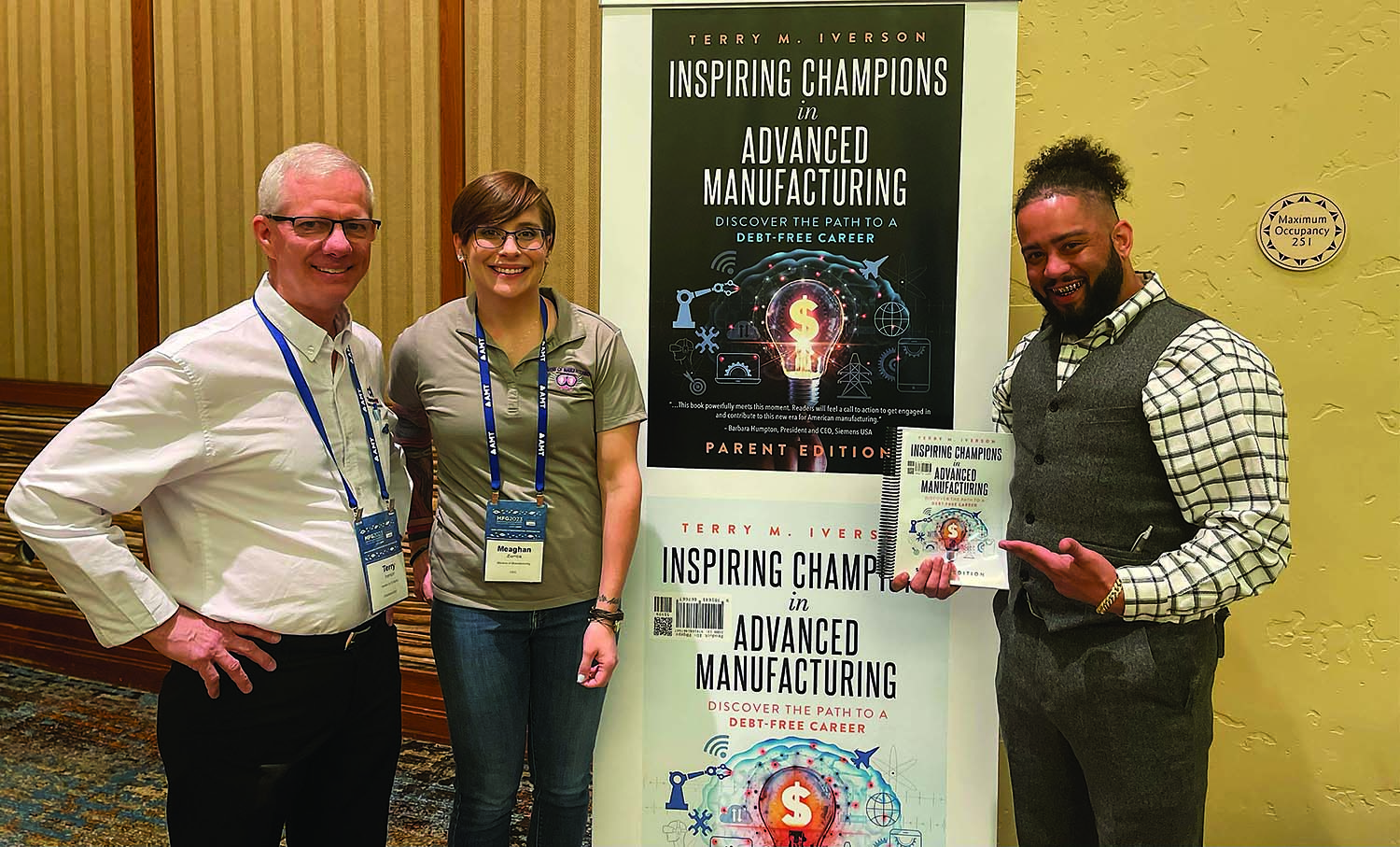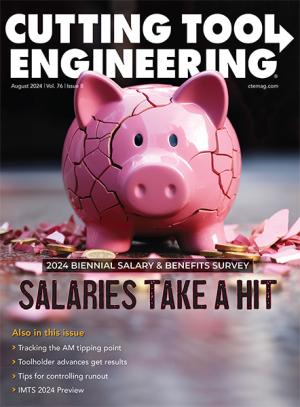In addition to an estimated 1,800 exhibitors, the 2024 International Manufacturing Technology Show (IMTS 2024) will once again feature the Smartforce Student Summit designed to inspire students to seek an education in STEM that leads to a career in manufacturing. The Student Summit will be in the East Building on the second floor. Drop by to witness the exciting things this industry is doing to build our workforce.
Manufacturing Ally Rally
In particular, look for a series of one hour panel discussions that will take place throughout the week at the Student Summit Amphitheatre (Booth 121140). Dubbed the “Manufacturing Ally Rally,” the panel discussions will begin at 11 a.m. Monday through Thursday and will be moderated by the top-notch leaders capable of inspiring all those in attendance.

Here’s a peek at the topics to be covered during the panel discussions:
Inspiring the Next Generation: Early Talent Pipeline — led by Toni Neary, director of community engagement and workforce innovation for SME, on Monday, Sept. 9.
Beyond Gender and Ethnicity: Understanding Diversity in Manufacturing — led by Drew Crowe, founder of the New American Manufacturing Renaissance, on Tuesday, Sept. 10.
Empowering Talent: New Approaches to Job Roles in Manufacturing — led by Meaghan Ziemba, host of the Mavens of Manufacturing podcast, on Wednesday, Sept. 11.
Collaboration: What does support look like? — led by Chris Luecke, host of the Manufacturing Happy Hour podcast, on Thursday, Sept. 12.
A final panel discussion with all of the panel moderators will take place at 11:30 a.m. Friday, Sept. 13, at the IMTS+ Main Stage located in the Grand Concourse.
CHAMPIONNow!
Also featured at the summit this year will be CHAMPIONNow! Located at Booth 121002, CHAMPIONNow! is a nonprofit organization whose mission is to change how American manufacturing is perceived in our nation. The group will provide more information about its Camp CHAMP outreach program and demonstrate three CNC tabletop machines at the center of the Camp CHAMP program. The machines will be in use making pens to be handed out to future young members of the skilled workforce.
Camp CHAMP is for rent, lease and sale with cobranded offerings that will allow anyone interested to make every day a manufacturing day in their region. Camp CHAMP is intended to provide industry members a ready plan to address the workforce shortage in their local communities. Camp CHAMP can be a turnkey solution for a Manufacturing Day event or part of year-round recruitment efforts.
In addition, CHAMPIONNow! will discuss how the group enlists the help of high schoolers to mentor middle school students in the art of CNC through its Camp CHAMP program. What’s more, the group supplies young attendees with information on why their parents should encourage their newfound interest in a manufacturing career. CHAMPIONNow! provides 300-plus pages of facts, figures and storylines for the students to take home and share with Mom and Dad. (Technical Education Post - American Technical Publishers at Booth 121008 will be selling both CHAMPIONNow! Books — Finding America’s Greatest Champion and Inspiring Champions in Advanced Manufacturing.)
According to SME, about 12,000 students and educators from 46 states participated in the 2022 Smartforce Student Summit, and about 20,000 are expected at this year’s event. About 70% of the audience comes from secondary education institutions. The summit is a perfect opportunity for more industry members and leaders to learn how to get involved and be part of the workforce solution. Cutting Tool Engineering, for its part, has provided CHAMPIONNow! with financial support and ample coverage to help the organization make a difference regionally and nationally.
Make the Student Summit part of your path during the show!
Exhibitors by Sector
Abrasive Machining/Sawing/Finishing — Showcasing equipment for tight-tolerance and precision surface finish applications, including grinding, sawing, cutoff machines, and finishing technologies such as lapping, balancing, honing and polishing machines. North Building
Additive Manufacturing — Displaying the latest developments in vat photopolymerization, power fed fusion, binder jetting, material jetting, sheet lamination, material extrusion and directed energy deposition. West Building
Automation — Featuring products and services for intelligent automation solutions such as vision systems, motion control, robotics, embedded sensors, and integrated packages featuring subtractive and additive hybrid machines. North Building
Fabricating & Lasers — Targets fabrication, waterjet machining and laser machining, as well as welding, metal treating and marking equipment. East Building
Gear Generation — Presenting the latest technologies for gear manufacturing equipment such as gear cutting, forming, finishing, broaching, shaping and slotting machines. North Building
Machine Components/Cleaning/Environmental — Highlighting the components you need to monitor and service your machines in a safe and environmentally responsible manner. East Building
Metal Removal — Focuses on innovations in metal-removal equipment, including machining centers, turning centers, drilling, boring, milling, EDM and more. South Building
Quality Assurance — Featuring metrology systems and equipment that help track and maintain machine accuracy. East Building
Software — Showcasing the latest software to help extract maximum efficiency from machine tools and optimize plant operations. East Building
Tooling & Workholding — Displaying newest cutting tools and workholding solutions that help shops reduce setup and machining time. West Building
Related Glossary Terms
- abrasive
abrasive
Substance used for grinding, honing, lapping, superfinishing and polishing. Examples include garnet, emery, corundum, silicon carbide, cubic boron nitride and diamond in various grit sizes.
- boring
boring
Enlarging a hole that already has been drilled or cored. Generally, it is an operation of truing the previously drilled hole with a single-point, lathe-type tool. Boring is essentially internal turning, in that usually a single-point cutting tool forms the internal shape. Some tools are available with two cutting edges to balance cutting forces.
- broaching
broaching
Operation in which a cutter progressively enlarges a slot or hole or shapes a workpiece exterior. Low teeth start the cut, intermediate teeth remove the majority of the material and high teeth finish the task. Broaching can be a one-step operation, as opposed to milling and slotting, which require repeated passes. Typically, however, broaching also involves multiple passes.
- centers
centers
Cone-shaped pins that support a workpiece by one or two ends during machining. The centers fit into holes drilled in the workpiece ends. Centers that turn with the workpiece are called “live” centers; those that do not are called “dead” centers.
- computer numerical control ( CNC)
computer numerical control ( CNC)
Microprocessor-based controller dedicated to a machine tool that permits the creation or modification of parts. Programmed numerical control activates the machine’s servos and spindle drives and controls the various machining operations. See DNC, direct numerical control; NC, numerical control.
- cutoff
cutoff
Step that prepares a slug, blank or other workpiece for machining or other processing by separating it from the original stock. Performed on lathes, chucking machines, automatic screw machines and other turning machines. Also performed on milling machines, machining centers with slitting saws and sawing machines with cold (circular) saws, hacksaws, bandsaws or abrasive cutoff saws. See saw, sawing machine; turning.
- electrical-discharge machining ( EDM)
electrical-discharge machining ( EDM)
Process that vaporizes conductive materials by controlled application of pulsed electrical current that flows between a workpiece and electrode (tool) in a dielectric fluid. Permits machining shapes to tight accuracies without the internal stresses conventional machining often generates. Useful in diemaking.
- extrusion
extrusion
Conversion of an ingot or billet into lengths of uniform cross section by forcing metal to flow plastically through a die orifice.
- gang cutting ( milling)
gang cutting ( milling)
Machining with several cutters mounted on a single arbor, generally for simultaneous cutting.
- grinding
grinding
Machining operation in which material is removed from the workpiece by a powered abrasive wheel, stone, belt, paste, sheet, compound, slurry, etc. Takes various forms: surface grinding (creates flat and/or squared surfaces); cylindrical grinding (for external cylindrical and tapered shapes, fillets, undercuts, etc.); centerless grinding; chamfering; thread and form grinding; tool and cutter grinding; offhand grinding; lapping and polishing (grinding with extremely fine grits to create ultrasmooth surfaces); honing; and disc grinding.
- lapping
lapping
Finishing operation in which a loose, fine-grain abrasive in a liquid medium abrades material. Extremely accurate process that corrects minor shape imperfections, refines surface finishes and produces a close fit between mating surfaces.
- laser machining
laser machining
Intensified, pulsed beams of light generated by lasers—typically carbon dioxide or neodium-doped yttrium aluminum garnet (Nd:YAG)—that drill, weld, engrave, mark, slit and caseharden. Usually under CNC, often at both high cutting rates (100 linear in./sec.) and high power (5kW or more). Lasers also are used in conjunction with in-process quality-control monitoring systems allowing measuring accuracies of 0.00001".
- metrology
metrology
Science of measurement; the principles on which precision machining, quality control and inspection are based. See precision machining, measurement.
- milling
milling
Machining operation in which metal or other material is removed by applying power to a rotating cutter. In vertical milling, the cutting tool is mounted vertically on the spindle. In horizontal milling, the cutting tool is mounted horizontally, either directly on the spindle or on an arbor. Horizontal milling is further broken down into conventional milling, where the cutter rotates opposite the direction of feed, or “up” into the workpiece; and climb milling, where the cutter rotates in the direction of feed, or “down” into the workpiece. Milling operations include plane or surface milling, endmilling, facemilling, angle milling, form milling and profiling.
- polishing
polishing
Abrasive process that improves surface finish and blends contours. Abrasive particles attached to a flexible backing abrade the workpiece.
- quality assurance ( quality control)
quality assurance ( quality control)
Terms denoting a formal program for monitoring product quality. The denotations are the same, but QC typically connotes a more traditional postmachining inspection system, while QA implies a more comprehensive approach, with emphasis on “total quality,” broad quality principles, statistical process control and other statistical methods.
- robotics
robotics
Discipline involving self-actuating and self-operating devices. Robots frequently imitate human capabilities, including the ability to manipulate physical objects while evaluating and reacting appropriately to various stimuli. See industrial robot; robot.
- sawing
sawing
Machining operation in which a powered machine, usually equipped with a blade having milled or ground teeth, is used to part material (cutoff) or give it a new shape (contour bandsawing, band machining). Four basic types of sawing operations are: hacksawing (power or manual operation in which the blade moves back and forth through the work, cutting on one of the strokes); cold or circular sawing (a rotating, circular, toothed blade parts the material much as a workshop table saw or radial-arm saw cuts wood); bandsawing (a flexible, toothed blade rides on wheels under tension and is guided through the work); and abrasive sawing (abrasive points attached to a fiber or metal backing part stock, could be considered a grinding operation).
- shaping
shaping
Using a shaper primarily to produce flat surfaces in horizontal, vertical or angular planes. It can also include the machining of curved surfaces, helixes, serrations and special work involving odd and irregular shapes. Often used for prototype or short-run manufacturing to eliminate the need for expensive special tooling or processes.
- slotting
slotting
Machining, normally milling, that creates slots, grooves and similar recesses in workpieces, including T-slots and dovetails.
- turning
turning
Workpiece is held in a chuck, mounted on a face plate or secured between centers and rotated while a cutting tool, normally a single-point tool, is fed into it along its periphery or across its end or face. Takes the form of straight turning (cutting along the periphery of the workpiece); taper turning (creating a taper); step turning (turning different-size diameters on the same work); chamfering (beveling an edge or shoulder); facing (cutting on an end); turning threads (usually external but can be internal); roughing (high-volume metal removal); and finishing (final light cuts). Performed on lathes, turning centers, chucking machines, automatic screw machines and similar machines.










